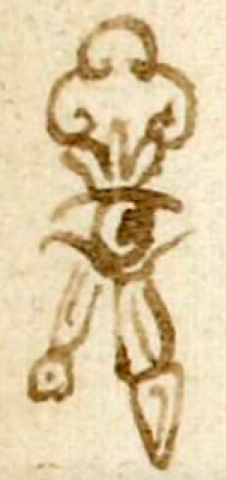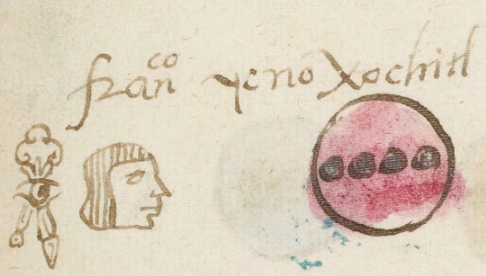Icnoxochitl (TV4r)
This black-line drawing of the compound glyph for the personal name Icnoxochitl (“Humble Flower,” attested here as a man’s name) shows an upright flower {xochitl) with a teary eye below it (suggesting humility or sadness, icno-). The flower is a rounded tripartite shape. The eye is a leaf shape in a European style. The tears coming down from the eye are two short streams of water, one ending in a turbinate shell and one ending in a droplet or bead. Each streaming tear has a line of current in the middle (showing movement).
Stephanie Wood
Glyphs that involve the element "icno" (humble, sad) very often involve tears, See below.
Stephanie Wood
franco ycnoxochitl
Francisco Icnoxochitl
Stephanie Wood
1574
Jeff Haskett-Wood
humilde, triste, flores

xochi(tl), flower, https://nahuatl.wired-humanities.org/content/xochitl
icno, humble, in a sad state, https://nahuatl.wired-humanities.org/content/icno
Humilde-Flor, o Triste-Flor
Stephanie Wood
El Libro de los Tributos de San Pablo Teocaltitlan, also known as the Codex Valeriano and Manuscrit Mexicain 376, is hosted by the Bibliothèque nationale de France, published on line in the digital resource, Gallica, https://gallica.bnf.fr/ark:/12148/btv1b8455947h/f15.item.r=Libro%20de%20...
The non-commercial reuse of images from the Bibliothèque nationale de France is free as long as the user is in compliance with the legislation in force and provides the citation: “Source gallica.bnf.fr / Bibliothèque nationale de France” or “Source gallica.bnf.fr / BnF.” We would also appreciate a citation to the Visual Lexicon of Aztec Hieroglyphs, https://aztecglyphs.wired-humanities.org/.





